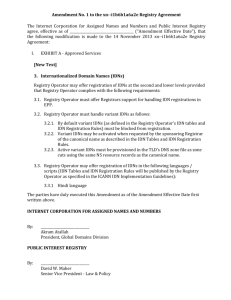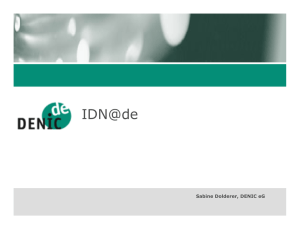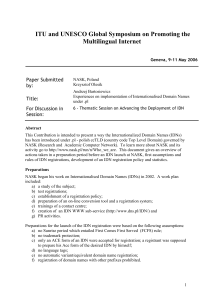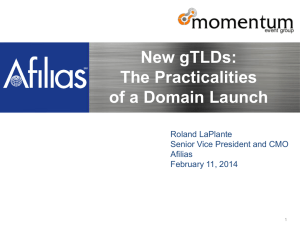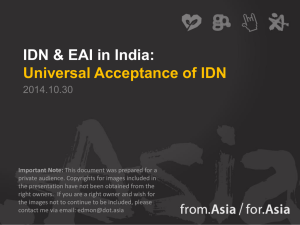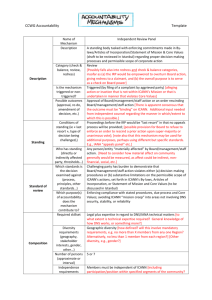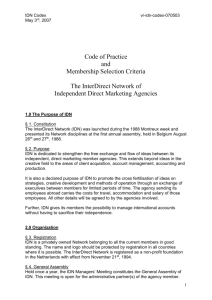Topic Detail - IDNs - Background
advertisement
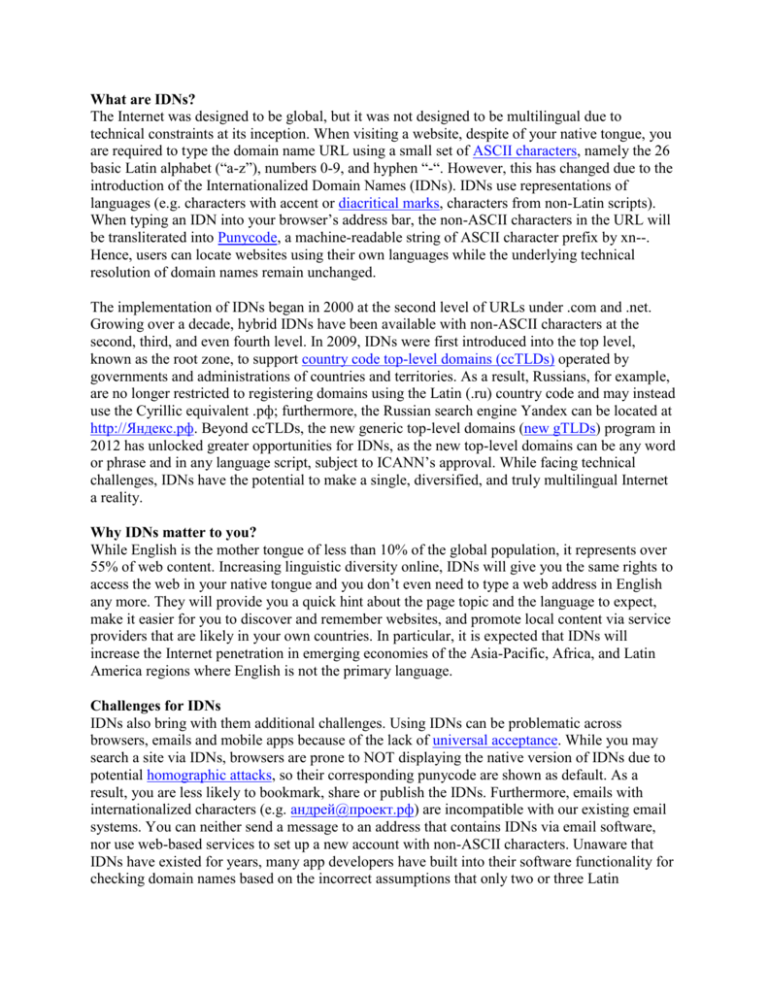
What are IDNs? The Internet was designed to be global, but it was not designed to be multilingual due to technical constraints at its inception. When visiting a website, despite of your native tongue, you are required to type the domain name URL using a small set of ASCII characters, namely the 26 basic Latin alphabet (“a-z”), numbers 0-9, and hyphen “-“. However, this has changed due to the introduction of the Internationalized Domain Names (IDNs). IDNs use representations of languages (e.g. characters with accent or diacritical marks, characters from non-Latin scripts). When typing an IDN into your browser’s address bar, the non-ASCII characters in the URL will be transliterated into Punycode, a machine-readable string of ASCII character prefix by xn--. Hence, users can locate websites using their own languages while the underlying technical resolution of domain names remain unchanged. The implementation of IDNs began in 2000 at the second level of URLs under .com and .net. Growing over a decade, hybrid IDNs have been available with non-ASCII characters at the second, third, and even fourth level. In 2009, IDNs were first introduced into the top level, known as the root zone, to support country code top-level domains (ccTLDs) operated by governments and administrations of countries and territories. As a result, Russians, for example, are no longer restricted to registering domains using the Latin (.ru) country code and may instead use the Cyrillic equivalent .рф; furthermore, the Russian search engine Yandex can be located at http://Яндекс.рф. Beyond ccTLDs, the new generic top-level domains (new gTLDs) program in 2012 has unlocked greater opportunities for IDNs, as the new top-level domains can be any word or phrase and in any language script, subject to ICANN’s approval. While facing technical challenges, IDNs have the potential to make a single, diversified, and truly multilingual Internet a reality. Why IDNs matter to you? While English is the mother tongue of less than 10% of the global population, it represents over 55% of web content. Increasing linguistic diversity online, IDNs will give you the same rights to access the web in your native tongue and you don’t even need to type a web address in English any more. They will provide you a quick hint about the page topic and the language to expect, make it easier for you to discover and remember websites, and promote local content via service providers that are likely in your own countries. In particular, it is expected that IDNs will increase the Internet penetration in emerging economies of the Asia-Pacific, Africa, and Latin America regions where English is not the primary language. Challenges for IDNs IDNs also bring with them additional challenges. Using IDNs can be problematic across browsers, emails and mobile apps because of the lack of universal acceptance. While you may search a site via IDNs, browsers are prone to NOT displaying the native version of IDNs due to potential homographic attacks, so their corresponding punycode are shown as default. As a result, you are less likely to bookmark, share or publish the IDNs. Furthermore, emails with internationalized characters (e.g. aндрей@проект.рф) are incompatible with our existing email systems. You can neither send a message to an address that contains IDNs via email software, nor use web-based services to set up a new account with non-ASCII characters. Unaware that IDNs have existed for years, many app developers have built into their software functionality for checking domain names based on the incorrect assumptions that only two or three Latin characters can exist at the top level. Because of this, some apps are unable to locate IDN sites. While still having a way to go, the universal acceptance of IDNs will ultimately improve your user experience, increasing the IDN uptake and realizing a truly multi-linguistic Internet. What is ICANN’s role in IDNs? Implementing IDNs is expected to impact on the development of domain name industry in emerging economies, as well as encounter challenges in terms of universal acceptance. Hence, it requires that several groups work together, including language experts, engineers, security experts, industry, government, and end-user communities. ICANN, as the organization mandated with the coordination and maintenance of the domain name system and in charge of ensuring the stable and secure operation of the Internet, brings together different stakeholders to develop policy for implementing IDNs. What are the IDN Policy and Program? When IDNs were first used at the second level (e.g. 실례.com), ICANN created the IDN Implementation Guidelines for register operators -- organizations that manage the technical operation of domains -- to follow. Over the years, ICANN has been working with registries to update these Guidelines. In 2009, the ICANN Board approved the IDN ccTLD Fast Track Process that enables countries and territories to offer national domain names with non-Latin characters. This is a milestone event in the development of IDN TLDs. As of today, 36 IDN ccTLDs representing 28 countries and territories have been rolled out and are in use. Presently, ICANN has been rolling out a wave of new gTLD applications, among which 116 applications are IDN gTLDs. This massive expansion of TLDs has brought new challenges. One key challenge is around setting new rules for determining the validity new top-level domain labels in a diverse array of language scripts and writing systems. These new rules are called “Label Generation Rule-set (LGR).” They identify which subsets of characters can be used to form a top-level domain, which characters may be confusable or variant to end users due to their visual similarity (e.g. 中国 vs.中國), and what other additional constraints may exist. Since this work requires linguistic expertise, ICANN facilitates the communications between language experts around the world and help them organize into Generation Panels to develop the LGR proposals for various scripts. An Integration Panel will then review these proposals and determine whether they are ready for implementation. So far, the proposals from the Arabic, Chinese, Japanese, and Armenian language community have been approved by ICANN. As part of this effort, Generation Panels are also working on the LGR Toolset, a software for checking the validity of IDN gTLDs; this will help ensure that registries have the capacity to operate their proposed IDN new gTLDs in a stable, secure manner. How the At-Large community has contributed to IDN Policy? With presence in more than 80 countries and territories, the At-Large community is the most geographically, linguistically, and culturally diverse stakeholder group at ICANN. Our members have published Policy Advice Statements on IDNs, universal acceptance, and WHOIS issues that have an internationalization component. We also participate in ICANN’s Generation Panels and mobilize interested individuals to take part in. Furthermore, experts within our community have hosted webinars to educate the broader audience and raise awareness of IDN issues. As a vocal and vigilant presence in the IDN activities of ICANN, we bring language and technical expertise and highlight the end-users' interests in policy discussions. How can you get involved? Do you want to help build a multilingual Internet benefiting the next billion Internet users? Get involved in At-Large! Our IDN Policy Working Group is open to anyone, even if you are not a member of the At-Large community. You may get to know like-minded members from all around the world, participate in its discussions on ICANN’s IDN Program, and join their conferences usually held during ICANN meetings. Contact staff@atlarge.icann.org to ask for more information. If you just want to be an observer in this Working Group, you may simply subscribe to its mailing list to follow the discussions and receive conference details. To directly take part in ICANN’s IDN program, you may volunteer in Generation Panels by joining an existing Generation Panel or starting a prospective one. Read this to learn about the language and technical expertise needed for Generation Panels. You can also contact idntlds@icann.org to learn more. Resources - World Report on Internationalised Domain Names 2014 - Speak up for your language - IDN Program Update at ICANN 52 Singapore - Useful Links and Related Documentation - IDN Reference Tables - IDN Document Depository - Community wiki for the LGR Project - Final Implementation Plan for IDN ccTLD Fast Track Process - APRALO-APAC Hub Webinar on IDNs on 09 April 2015
